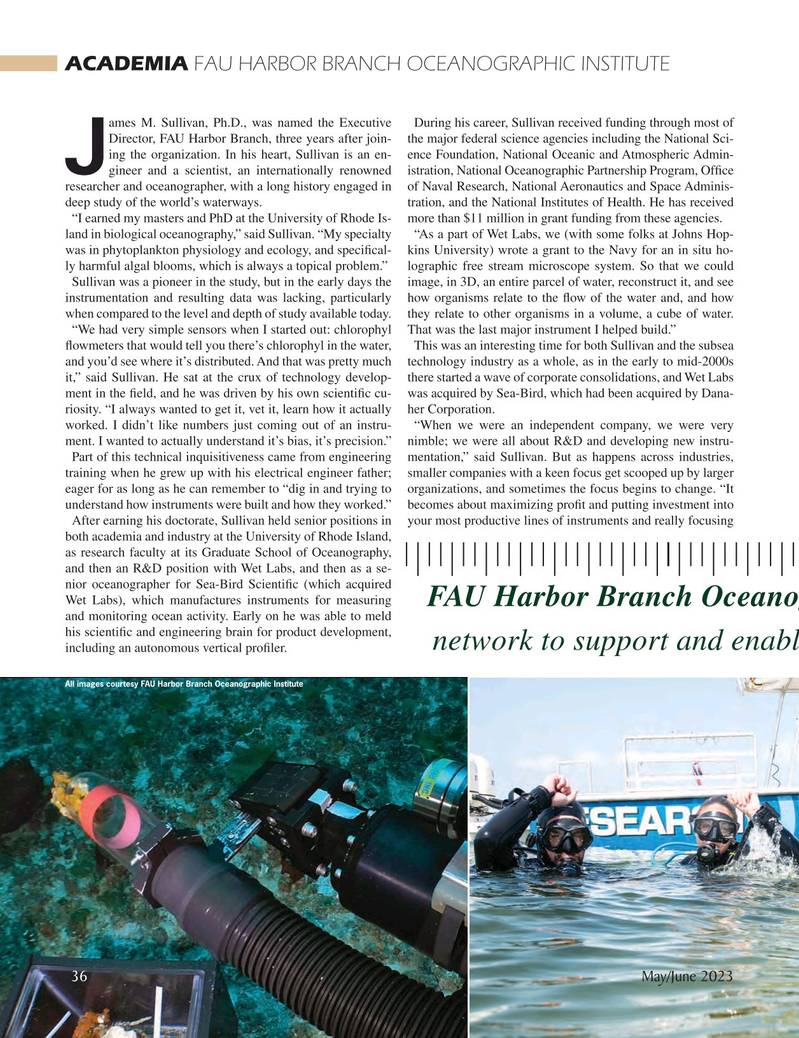
Page 36: of Marine Technology Magazine (May 2023)
Read this page in Pdf, Flash or Html5 edition of May 2023 Marine Technology Magazine
ACADEMIA FAU HARBOR BRANCH OCEANOGRAPHIC INSTITUTE ames M. Sullivan, Ph.D., was named the Executive During his career, Sullivan received funding through most of
Director, FAU Harbor Branch, three years after join- the major federal science agencies including the National Sci- ing the organization. In his heart, Sullivan is an en- ence Foundation, National Oceanic and Atmospheric Admin-
Jgineer and a scientist, an internationally renowned istration, National Oceanographic Partnership Program, Of? ce researcher and oceanographer, with a long history engaged in of Naval Research, National Aeronautics and Space Adminis- deep study of the world’s waterways. tration, and the National Institutes of Health. He has received “I earned my masters and PhD at the University of Rhode Is- more than $11 million in grant funding from these agencies. land in biological oceanography,” said Sullivan. “My specialty “As a part of Wet Labs, we (with some folks at Johns Hop- was in phytoplankton physiology and ecology, and speci? cal- kins University) wrote a grant to the Navy for an in situ ho- ly harmful algal blooms, which is always a topical problem.” lographic free stream microscope system. So that we could
Sullivan was a pioneer in the study, but in the early days the image, in 3D, an entire parcel of water, reconstruct it, and see instrumentation and resulting data was lacking, particularly how organisms relate to the ? ow of the water and, and how when compared to the level and depth of study available today. they relate to other organisms in a volume, a cube of water. “We had very simple sensors when I started out: chlorophyl That was the last major instrument I helped build.” ? owmeters that would tell you there’s chlorophyl in the water, This was an interesting time for both Sullivan and the subsea and you’d see where it’s distributed. And that was pretty much technology industry as a whole, as in the early to mid-2000s it,” said Sullivan. He sat at the crux of technology develop- there started a wave of corporate consolidations, and Wet Labs ment in the ? eld, and he was driven by his own scienti? c cu- was acquired by Sea-Bird, which had been acquired by Dana- riosity. “I always wanted to get it, vet it, learn how it actually her Corporation.
worked. I didn’t like numbers just coming out of an instru- “When we were an independent company, we were very ment. I wanted to actually understand it’s bias, it’s precision.” nimble; we were all about R&D and developing new instru-
Part of this technical inquisitiveness came from engineering mentation,” said Sullivan. But as happens across industries, training when he grew up with his electrical engineer father; smaller companies with a keen focus get scooped up by larger eager for as long as he can remember to “dig in and trying to organizations, and sometimes the focus begins to change. “It understand how instruments were built and how they worked.” becomes about maximizing pro? t and putting investment into
After earning his doctorate, Sullivan held senior positions in your most productive lines of instruments and really focusing both academia and industry at the University of Rhode Island, as research faculty at its Graduate School of Oceanography, and then an R&D position with Wet Labs, and then as a se- nior oceanographer for Sea-Bird Scienti? c (which acquired
Wet Labs), which manufactures instruments for measuring
FAU Harbor Branch Oceanog and monitoring ocean activity. Early on he was able to meld his scienti? c and engineering brain for product development, network to support and enable including an autonomous vertical pro? ler.
All images courtesy FAU Harbor Branch Oceanographic Institute 36 May/June 2023
MTR #4 (34-47).indd 36 6/1/2023 10:17:38 AM

 35
35

 37
37
